Clinical Reasoning Cycle: Analyzing Mrs. Randall's Case in Orthopedics
VerifiedAdded on 2023/06/07
|9
|2517
|260
Homework Assignment
AI Summary
This assignment delves into the application of the clinical reasoning cycle in the context of Mrs. Randall, a 76-year-old patient admitted to the orthopedic ward following a fall. The assignment meticulously examines the various stages of the clinical reasoning cycle, starting with cue collection and information gathering, including Mrs. Randall's vital signs, medical history, and presenting symptoms such as pain and redness in her left foot. The analysis proceeds to information processing, identifying abnormal cues like elevated blood pressure and pulse rate. Problem identification includes both actual and potential nursing diagnoses, such as altered pulse rate related to tachycardia and the risk of a fractured metatarsal bone. The assignment then outlines proposed nursing interventions, including pain management, medication administration (antihypertensives and antianxiety), psychological support, and monitoring. Finally, it addresses the evaluation phase, emphasizing the need to assess the effectiveness of interventions by monitoring Mrs. Randall's vital signs and the condition of her foot. The assignment underscores the importance of clinical reasoning in making informed decisions and providing effective patient care.
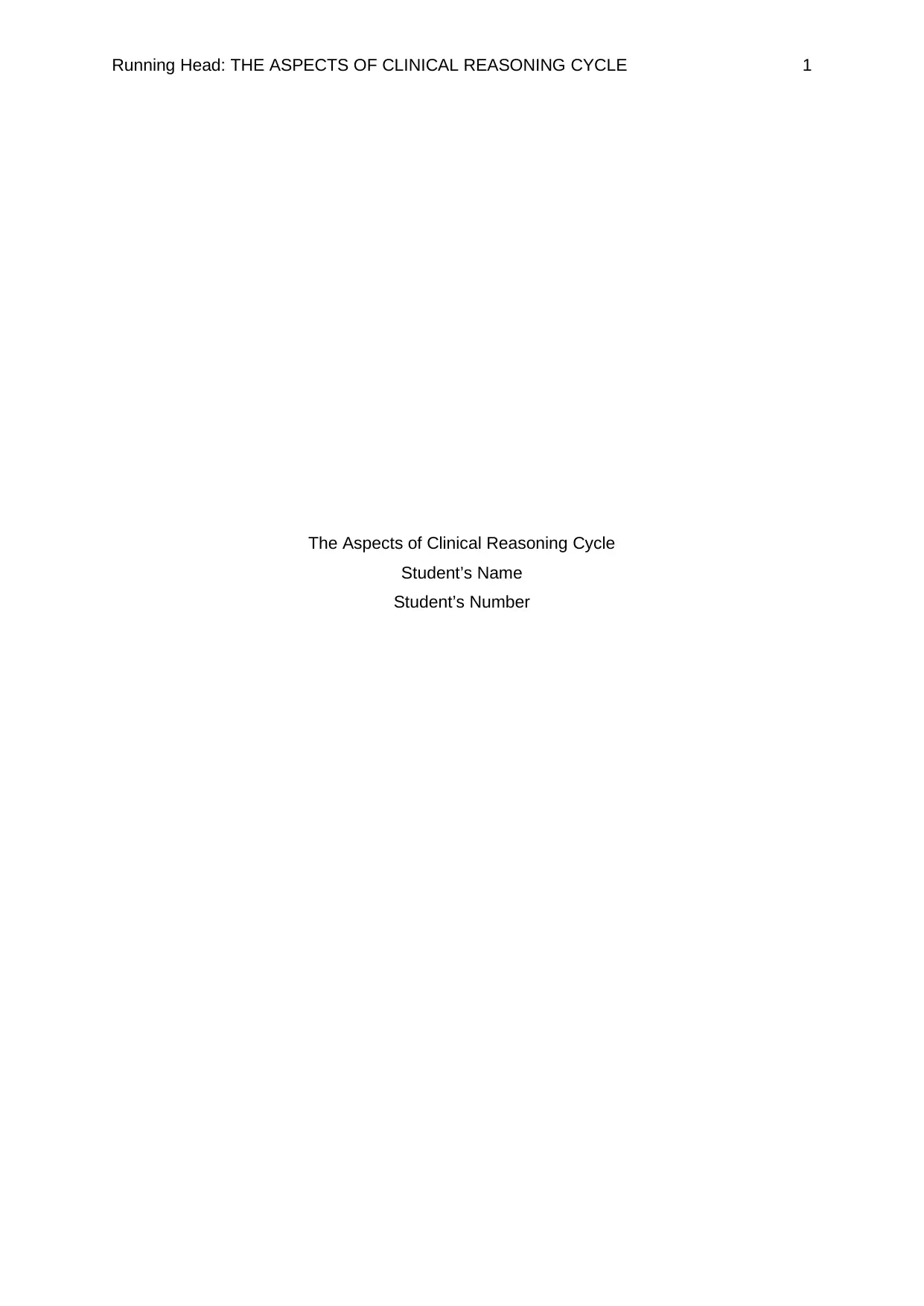
Running Head: THE ASPECTS OF CLINICAL REASONING CYCLE 1
The Aspects of Clinical Reasoning Cycle
Student’s Name
Student’s Number
The Aspects of Clinical Reasoning Cycle
Student’s Name
Student’s Number
Paraphrase This Document
Need a fresh take? Get an instant paraphrase of this document with our AI Paraphraser
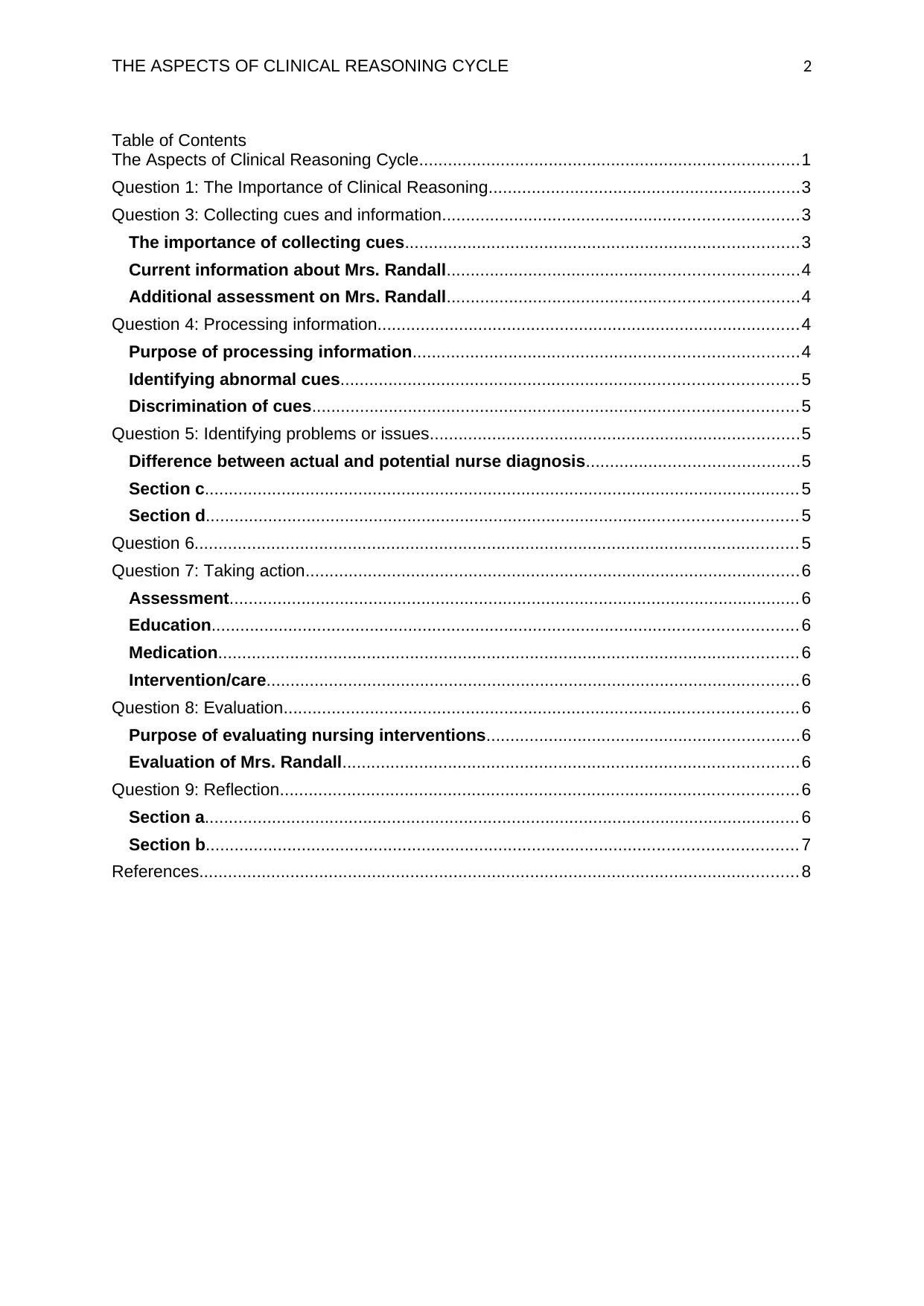
THE ASPECTS OF CLINICAL REASONING CYCLE 2
Table of Contents
The Aspects of Clinical Reasoning Cycle...............................................................................1
Question 1: The Importance of Clinical Reasoning.................................................................3
Question 3: Collecting cues and information..........................................................................3
The importance of collecting cues..................................................................................3
Current information about Mrs. Randall.........................................................................4
Additional assessment on Mrs. Randall.........................................................................4
Question 4: Processing information........................................................................................4
Purpose of processing information................................................................................4
Identifying abnormal cues...............................................................................................5
Discrimination of cues.....................................................................................................5
Question 5: Identifying problems or issues.............................................................................5
Difference between actual and potential nurse diagnosis............................................5
Section c............................................................................................................................ 5
Section d........................................................................................................................... 5
Question 6.............................................................................................................................. 5
Question 7: Taking action.......................................................................................................6
Assessment....................................................................................................................... 6
Education.......................................................................................................................... 6
Medication......................................................................................................................... 6
Intervention/care...............................................................................................................6
Question 8: Evaluation........................................................................................................... 6
Purpose of evaluating nursing interventions.................................................................6
Evaluation of Mrs. Randall...............................................................................................6
Question 9: Reflection............................................................................................................6
Section a............................................................................................................................ 6
Section b........................................................................................................................... 7
References............................................................................................................................. 8
Table of Contents
The Aspects of Clinical Reasoning Cycle...............................................................................1
Question 1: The Importance of Clinical Reasoning.................................................................3
Question 3: Collecting cues and information..........................................................................3
The importance of collecting cues..................................................................................3
Current information about Mrs. Randall.........................................................................4
Additional assessment on Mrs. Randall.........................................................................4
Question 4: Processing information........................................................................................4
Purpose of processing information................................................................................4
Identifying abnormal cues...............................................................................................5
Discrimination of cues.....................................................................................................5
Question 5: Identifying problems or issues.............................................................................5
Difference between actual and potential nurse diagnosis............................................5
Section c............................................................................................................................ 5
Section d........................................................................................................................... 5
Question 6.............................................................................................................................. 5
Question 7: Taking action.......................................................................................................6
Assessment....................................................................................................................... 6
Education.......................................................................................................................... 6
Medication......................................................................................................................... 6
Intervention/care...............................................................................................................6
Question 8: Evaluation........................................................................................................... 6
Purpose of evaluating nursing interventions.................................................................6
Evaluation of Mrs. Randall...............................................................................................6
Question 9: Reflection............................................................................................................6
Section a............................................................................................................................ 6
Section b........................................................................................................................... 7
References............................................................................................................................. 8
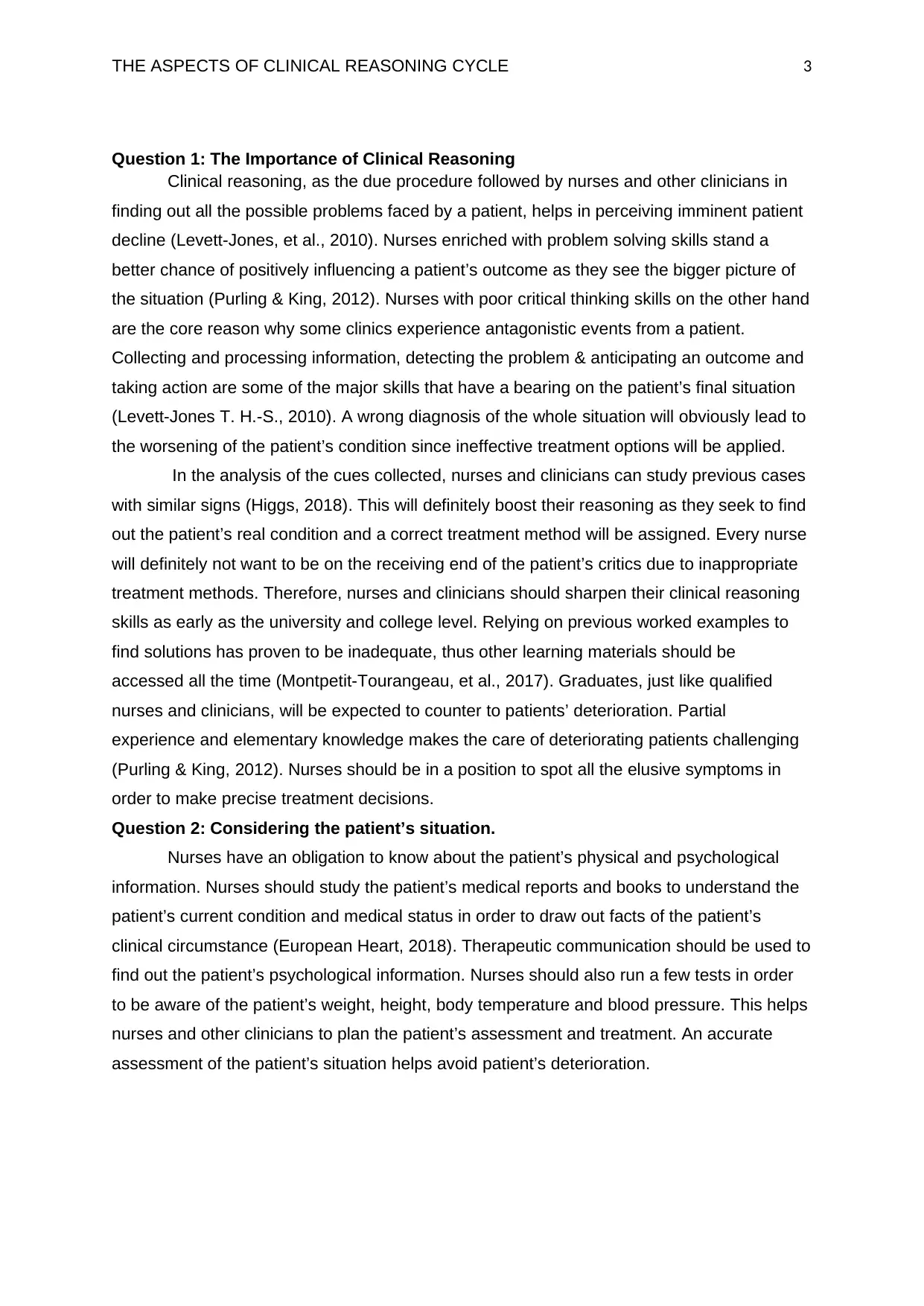
THE ASPECTS OF CLINICAL REASONING CYCLE 3
Question 1: The Importance of Clinical Reasoning
Clinical reasoning, as the due procedure followed by nurses and other clinicians in
finding out all the possible problems faced by a patient, helps in perceiving imminent patient
decline (Levett-Jones, et al., 2010). Nurses enriched with problem solving skills stand a
better chance of positively influencing a patient’s outcome as they see the bigger picture of
the situation (Purling & King, 2012). Nurses with poor critical thinking skills on the other hand
are the core reason why some clinics experience antagonistic events from a patient.
Collecting and processing information, detecting the problem & anticipating an outcome and
taking action are some of the major skills that have a bearing on the patient’s final situation
(Levett-Jones T. H.-S., 2010). A wrong diagnosis of the whole situation will obviously lead to
the worsening of the patient’s condition since ineffective treatment options will be applied.
In the analysis of the cues collected, nurses and clinicians can study previous cases
with similar signs (Higgs, 2018). This will definitely boost their reasoning as they seek to find
out the patient’s real condition and a correct treatment method will be assigned. Every nurse
will definitely not want to be on the receiving end of the patient’s critics due to inappropriate
treatment methods. Therefore, nurses and clinicians should sharpen their clinical reasoning
skills as early as the university and college level. Relying on previous worked examples to
find solutions has proven to be inadequate, thus other learning materials should be
accessed all the time (Montpetit-Tourangeau, et al., 2017). Graduates, just like qualified
nurses and clinicians, will be expected to counter to patients’ deterioration. Partial
experience and elementary knowledge makes the care of deteriorating patients challenging
(Purling & King, 2012). Nurses should be in a position to spot all the elusive symptoms in
order to make precise treatment decisions.
Question 2: Considering the patient’s situation.
Nurses have an obligation to know about the patient’s physical and psychological
information. Nurses should study the patient’s medical reports and books to understand the
patient’s current condition and medical status in order to draw out facts of the patient’s
clinical circumstance (European Heart, 2018). Therapeutic communication should be used to
find out the patient’s psychological information. Nurses should also run a few tests in order
to be aware of the patient’s weight, height, body temperature and blood pressure. This helps
nurses and other clinicians to plan the patient’s assessment and treatment. An accurate
assessment of the patient’s situation helps avoid patient’s deterioration.
Question 1: The Importance of Clinical Reasoning
Clinical reasoning, as the due procedure followed by nurses and other clinicians in
finding out all the possible problems faced by a patient, helps in perceiving imminent patient
decline (Levett-Jones, et al., 2010). Nurses enriched with problem solving skills stand a
better chance of positively influencing a patient’s outcome as they see the bigger picture of
the situation (Purling & King, 2012). Nurses with poor critical thinking skills on the other hand
are the core reason why some clinics experience antagonistic events from a patient.
Collecting and processing information, detecting the problem & anticipating an outcome and
taking action are some of the major skills that have a bearing on the patient’s final situation
(Levett-Jones T. H.-S., 2010). A wrong diagnosis of the whole situation will obviously lead to
the worsening of the patient’s condition since ineffective treatment options will be applied.
In the analysis of the cues collected, nurses and clinicians can study previous cases
with similar signs (Higgs, 2018). This will definitely boost their reasoning as they seek to find
out the patient’s real condition and a correct treatment method will be assigned. Every nurse
will definitely not want to be on the receiving end of the patient’s critics due to inappropriate
treatment methods. Therefore, nurses and clinicians should sharpen their clinical reasoning
skills as early as the university and college level. Relying on previous worked examples to
find solutions has proven to be inadequate, thus other learning materials should be
accessed all the time (Montpetit-Tourangeau, et al., 2017). Graduates, just like qualified
nurses and clinicians, will be expected to counter to patients’ deterioration. Partial
experience and elementary knowledge makes the care of deteriorating patients challenging
(Purling & King, 2012). Nurses should be in a position to spot all the elusive symptoms in
order to make precise treatment decisions.
Question 2: Considering the patient’s situation.
Nurses have an obligation to know about the patient’s physical and psychological
information. Nurses should study the patient’s medical reports and books to understand the
patient’s current condition and medical status in order to draw out facts of the patient’s
clinical circumstance (European Heart, 2018). Therapeutic communication should be used to
find out the patient’s psychological information. Nurses should also run a few tests in order
to be aware of the patient’s weight, height, body temperature and blood pressure. This helps
nurses and other clinicians to plan the patient’s assessment and treatment. An accurate
assessment of the patient’s situation helps avoid patient’s deterioration.
⊘ This is a preview!⊘
Do you want full access?
Subscribe today to unlock all pages.

Trusted by 1+ million students worldwide
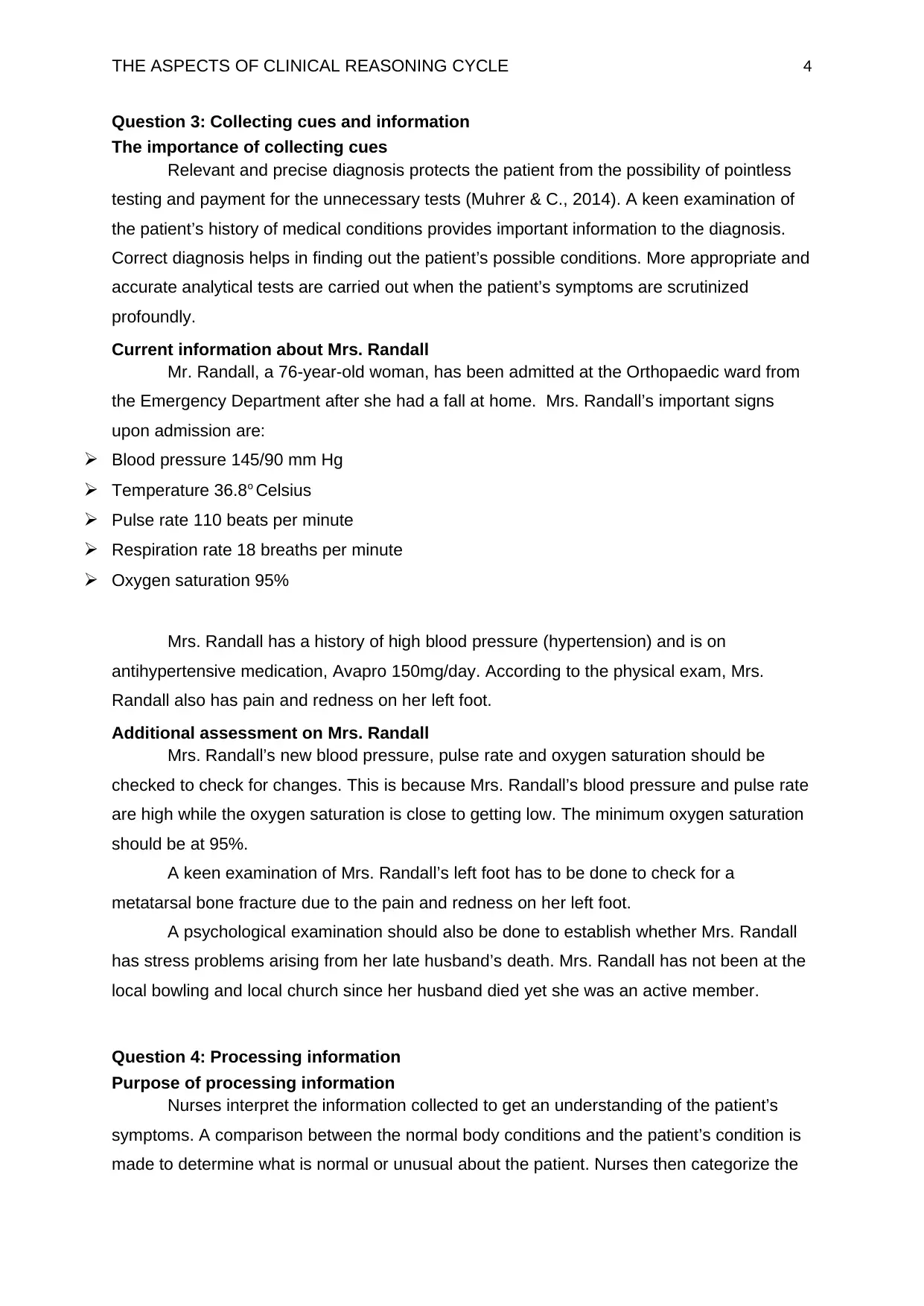
THE ASPECTS OF CLINICAL REASONING CYCLE 4
Question 3: Collecting cues and information
The importance of collecting cues
Relevant and precise diagnosis protects the patient from the possibility of pointless
testing and payment for the unnecessary tests (Muhrer & C., 2014). A keen examination of
the patient’s history of medical conditions provides important information to the diagnosis.
Correct diagnosis helps in finding out the patient’s possible conditions. More appropriate and
accurate analytical tests are carried out when the patient’s symptoms are scrutinized
profoundly.
Current information about Mrs. Randall
Mr. Randall, a 76-year-old woman, has been admitted at the Orthopaedic ward from
the Emergency Department after she had a fall at home. Mrs. Randall’s important signs
upon admission are:
Blood pressure 145/90 mm Hg
Temperature 36.8o Celsius
Pulse rate 110 beats per minute
Respiration rate 18 breaths per minute
Oxygen saturation 95%
Mrs. Randall has a history of high blood pressure (hypertension) and is on
antihypertensive medication, Avapro 150mg/day. According to the physical exam, Mrs.
Randall also has pain and redness on her left foot.
Additional assessment on Mrs. Randall
Mrs. Randall’s new blood pressure, pulse rate and oxygen saturation should be
checked to check for changes. This is because Mrs. Randall’s blood pressure and pulse rate
are high while the oxygen saturation is close to getting low. The minimum oxygen saturation
should be at 95%.
A keen examination of Mrs. Randall’s left foot has to be done to check for a
metatarsal bone fracture due to the pain and redness on her left foot.
A psychological examination should also be done to establish whether Mrs. Randall
has stress problems arising from her late husband’s death. Mrs. Randall has not been at the
local bowling and local church since her husband died yet she was an active member.
Question 4: Processing information
Purpose of processing information
Nurses interpret the information collected to get an understanding of the patient’s
symptoms. A comparison between the normal body conditions and the patient’s condition is
made to determine what is normal or unusual about the patient. Nurses then categorize the
Question 3: Collecting cues and information
The importance of collecting cues
Relevant and precise diagnosis protects the patient from the possibility of pointless
testing and payment for the unnecessary tests (Muhrer & C., 2014). A keen examination of
the patient’s history of medical conditions provides important information to the diagnosis.
Correct diagnosis helps in finding out the patient’s possible conditions. More appropriate and
accurate analytical tests are carried out when the patient’s symptoms are scrutinized
profoundly.
Current information about Mrs. Randall
Mr. Randall, a 76-year-old woman, has been admitted at the Orthopaedic ward from
the Emergency Department after she had a fall at home. Mrs. Randall’s important signs
upon admission are:
Blood pressure 145/90 mm Hg
Temperature 36.8o Celsius
Pulse rate 110 beats per minute
Respiration rate 18 breaths per minute
Oxygen saturation 95%
Mrs. Randall has a history of high blood pressure (hypertension) and is on
antihypertensive medication, Avapro 150mg/day. According to the physical exam, Mrs.
Randall also has pain and redness on her left foot.
Additional assessment on Mrs. Randall
Mrs. Randall’s new blood pressure, pulse rate and oxygen saturation should be
checked to check for changes. This is because Mrs. Randall’s blood pressure and pulse rate
are high while the oxygen saturation is close to getting low. The minimum oxygen saturation
should be at 95%.
A keen examination of Mrs. Randall’s left foot has to be done to check for a
metatarsal bone fracture due to the pain and redness on her left foot.
A psychological examination should also be done to establish whether Mrs. Randall
has stress problems arising from her late husband’s death. Mrs. Randall has not been at the
local bowling and local church since her husband died yet she was an active member.
Question 4: Processing information
Purpose of processing information
Nurses interpret the information collected to get an understanding of the patient’s
symptoms. A comparison between the normal body conditions and the patient’s condition is
made to determine what is normal or unusual about the patient. Nurses then categorize the
Paraphrase This Document
Need a fresh take? Get an instant paraphrase of this document with our AI Paraphraser
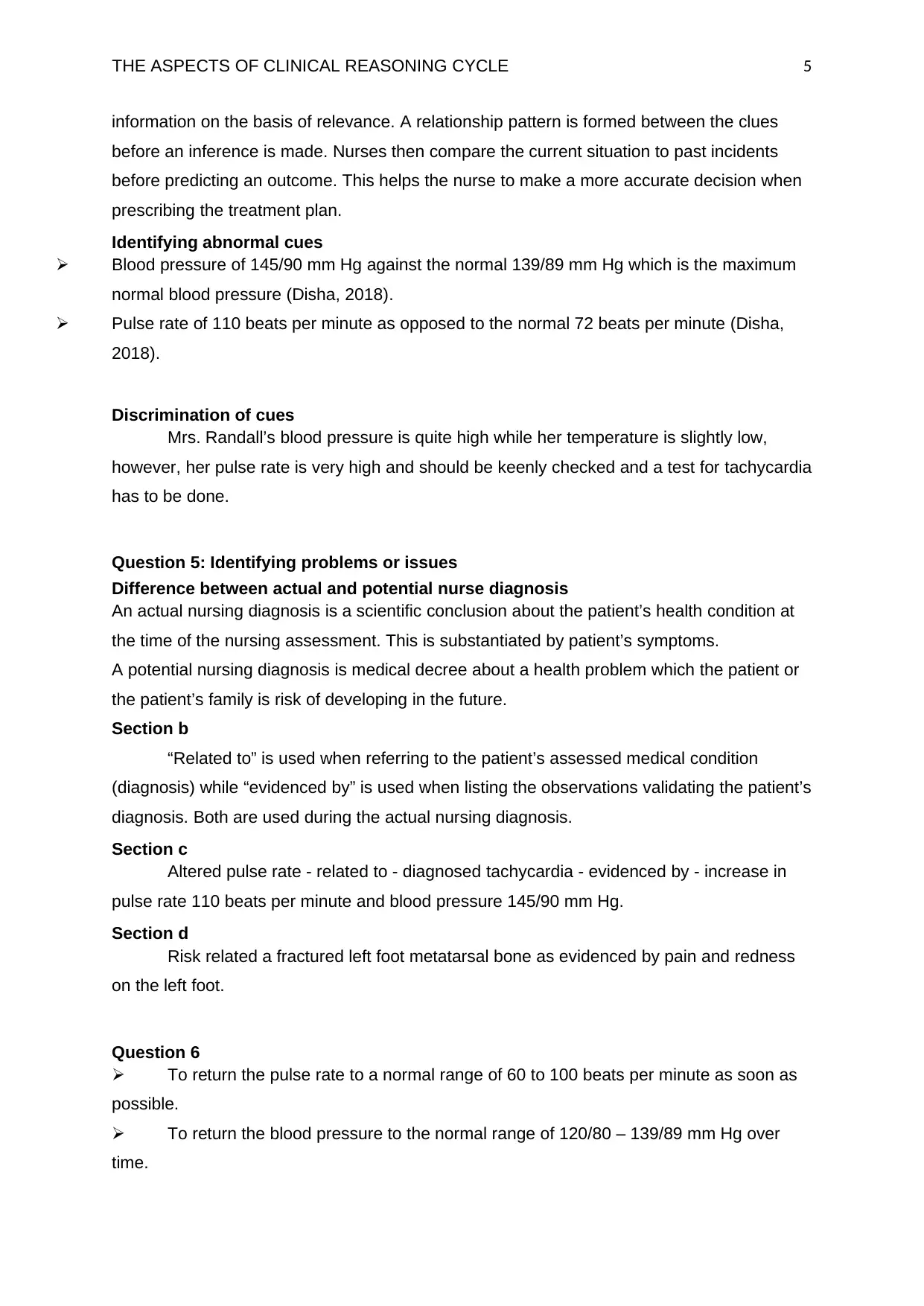
THE ASPECTS OF CLINICAL REASONING CYCLE 5
information on the basis of relevance. A relationship pattern is formed between the clues
before an inference is made. Nurses then compare the current situation to past incidents
before predicting an outcome. This helps the nurse to make a more accurate decision when
prescribing the treatment plan.
Identifying abnormal cues
Blood pressure of 145/90 mm Hg against the normal 139/89 mm Hg which is the maximum
normal blood pressure (Disha, 2018).
Pulse rate of 110 beats per minute as opposed to the normal 72 beats per minute (Disha,
2018).
Discrimination of cues
Mrs. Randall’s blood pressure is quite high while her temperature is slightly low,
however, her pulse rate is very high and should be keenly checked and a test for tachycardia
has to be done.
Question 5: Identifying problems or issues
Difference between actual and potential nurse diagnosis
An actual nursing diagnosis is a scientific conclusion about the patient’s health condition at
the time of the nursing assessment. This is substantiated by patient’s symptoms.
A potential nursing diagnosis is medical decree about a health problem which the patient or
the patient’s family is risk of developing in the future.
Section b
“Related to” is used when referring to the patient’s assessed medical condition
(diagnosis) while “evidenced by” is used when listing the observations validating the patient’s
diagnosis. Both are used during the actual nursing diagnosis.
Section c
Altered pulse rate - related to - diagnosed tachycardia - evidenced by - increase in
pulse rate 110 beats per minute and blood pressure 145/90 mm Hg.
Section d
Risk related a fractured left foot metatarsal bone as evidenced by pain and redness
on the left foot.
Question 6
To return the pulse rate to a normal range of 60 to 100 beats per minute as soon as
possible.
To return the blood pressure to the normal range of 120/80 – 139/89 mm Hg over
time.
information on the basis of relevance. A relationship pattern is formed between the clues
before an inference is made. Nurses then compare the current situation to past incidents
before predicting an outcome. This helps the nurse to make a more accurate decision when
prescribing the treatment plan.
Identifying abnormal cues
Blood pressure of 145/90 mm Hg against the normal 139/89 mm Hg which is the maximum
normal blood pressure (Disha, 2018).
Pulse rate of 110 beats per minute as opposed to the normal 72 beats per minute (Disha,
2018).
Discrimination of cues
Mrs. Randall’s blood pressure is quite high while her temperature is slightly low,
however, her pulse rate is very high and should be keenly checked and a test for tachycardia
has to be done.
Question 5: Identifying problems or issues
Difference between actual and potential nurse diagnosis
An actual nursing diagnosis is a scientific conclusion about the patient’s health condition at
the time of the nursing assessment. This is substantiated by patient’s symptoms.
A potential nursing diagnosis is medical decree about a health problem which the patient or
the patient’s family is risk of developing in the future.
Section b
“Related to” is used when referring to the patient’s assessed medical condition
(diagnosis) while “evidenced by” is used when listing the observations validating the patient’s
diagnosis. Both are used during the actual nursing diagnosis.
Section c
Altered pulse rate - related to - diagnosed tachycardia - evidenced by - increase in
pulse rate 110 beats per minute and blood pressure 145/90 mm Hg.
Section d
Risk related a fractured left foot metatarsal bone as evidenced by pain and redness
on the left foot.
Question 6
To return the pulse rate to a normal range of 60 to 100 beats per minute as soon as
possible.
To return the blood pressure to the normal range of 120/80 – 139/89 mm Hg over
time.
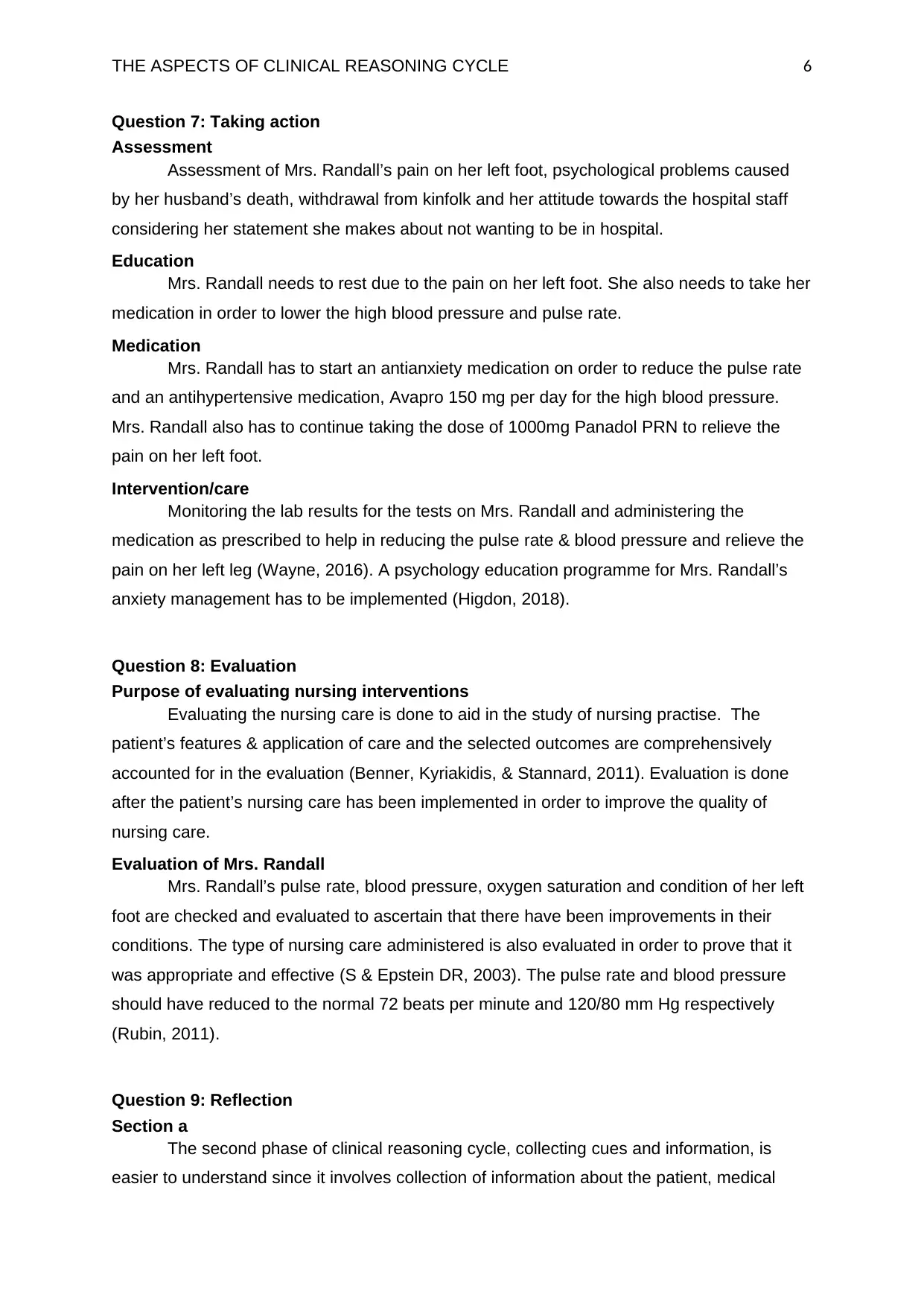
THE ASPECTS OF CLINICAL REASONING CYCLE 6
Question 7: Taking action
Assessment
Assessment of Mrs. Randall’s pain on her left foot, psychological problems caused
by her husband’s death, withdrawal from kinfolk and her attitude towards the hospital staff
considering her statement she makes about not wanting to be in hospital.
Education
Mrs. Randall needs to rest due to the pain on her left foot. She also needs to take her
medication in order to lower the high blood pressure and pulse rate.
Medication
Mrs. Randall has to start an antianxiety medication on order to reduce the pulse rate
and an antihypertensive medication, Avapro 150 mg per day for the high blood pressure.
Mrs. Randall also has to continue taking the dose of 1000mg Panadol PRN to relieve the
pain on her left foot.
Intervention/care
Monitoring the lab results for the tests on Mrs. Randall and administering the
medication as prescribed to help in reducing the pulse rate & blood pressure and relieve the
pain on her left leg (Wayne, 2016). A psychology education programme for Mrs. Randall’s
anxiety management has to be implemented (Higdon, 2018).
Question 8: Evaluation
Purpose of evaluating nursing interventions
Evaluating the nursing care is done to aid in the study of nursing practise. The
patient’s features & application of care and the selected outcomes are comprehensively
accounted for in the evaluation (Benner, Kyriakidis, & Stannard, 2011). Evaluation is done
after the patient’s nursing care has been implemented in order to improve the quality of
nursing care.
Evaluation of Mrs. Randall
Mrs. Randall’s pulse rate, blood pressure, oxygen saturation and condition of her left
foot are checked and evaluated to ascertain that there have been improvements in their
conditions. The type of nursing care administered is also evaluated in order to prove that it
was appropriate and effective (S & Epstein DR, 2003). The pulse rate and blood pressure
should have reduced to the normal 72 beats per minute and 120/80 mm Hg respectively
(Rubin, 2011).
Question 9: Reflection
Section a
The second phase of clinical reasoning cycle, collecting cues and information, is
easier to understand since it involves collection of information about the patient, medical
Question 7: Taking action
Assessment
Assessment of Mrs. Randall’s pain on her left foot, psychological problems caused
by her husband’s death, withdrawal from kinfolk and her attitude towards the hospital staff
considering her statement she makes about not wanting to be in hospital.
Education
Mrs. Randall needs to rest due to the pain on her left foot. She also needs to take her
medication in order to lower the high blood pressure and pulse rate.
Medication
Mrs. Randall has to start an antianxiety medication on order to reduce the pulse rate
and an antihypertensive medication, Avapro 150 mg per day for the high blood pressure.
Mrs. Randall also has to continue taking the dose of 1000mg Panadol PRN to relieve the
pain on her left foot.
Intervention/care
Monitoring the lab results for the tests on Mrs. Randall and administering the
medication as prescribed to help in reducing the pulse rate & blood pressure and relieve the
pain on her left leg (Wayne, 2016). A psychology education programme for Mrs. Randall’s
anxiety management has to be implemented (Higdon, 2018).
Question 8: Evaluation
Purpose of evaluating nursing interventions
Evaluating the nursing care is done to aid in the study of nursing practise. The
patient’s features & application of care and the selected outcomes are comprehensively
accounted for in the evaluation (Benner, Kyriakidis, & Stannard, 2011). Evaluation is done
after the patient’s nursing care has been implemented in order to improve the quality of
nursing care.
Evaluation of Mrs. Randall
Mrs. Randall’s pulse rate, blood pressure, oxygen saturation and condition of her left
foot are checked and evaluated to ascertain that there have been improvements in their
conditions. The type of nursing care administered is also evaluated in order to prove that it
was appropriate and effective (S & Epstein DR, 2003). The pulse rate and blood pressure
should have reduced to the normal 72 beats per minute and 120/80 mm Hg respectively
(Rubin, 2011).
Question 9: Reflection
Section a
The second phase of clinical reasoning cycle, collecting cues and information, is
easier to understand since it involves collection of information about the patient, medical
⊘ This is a preview!⊘
Do you want full access?
Subscribe today to unlock all pages.

Trusted by 1+ million students worldwide
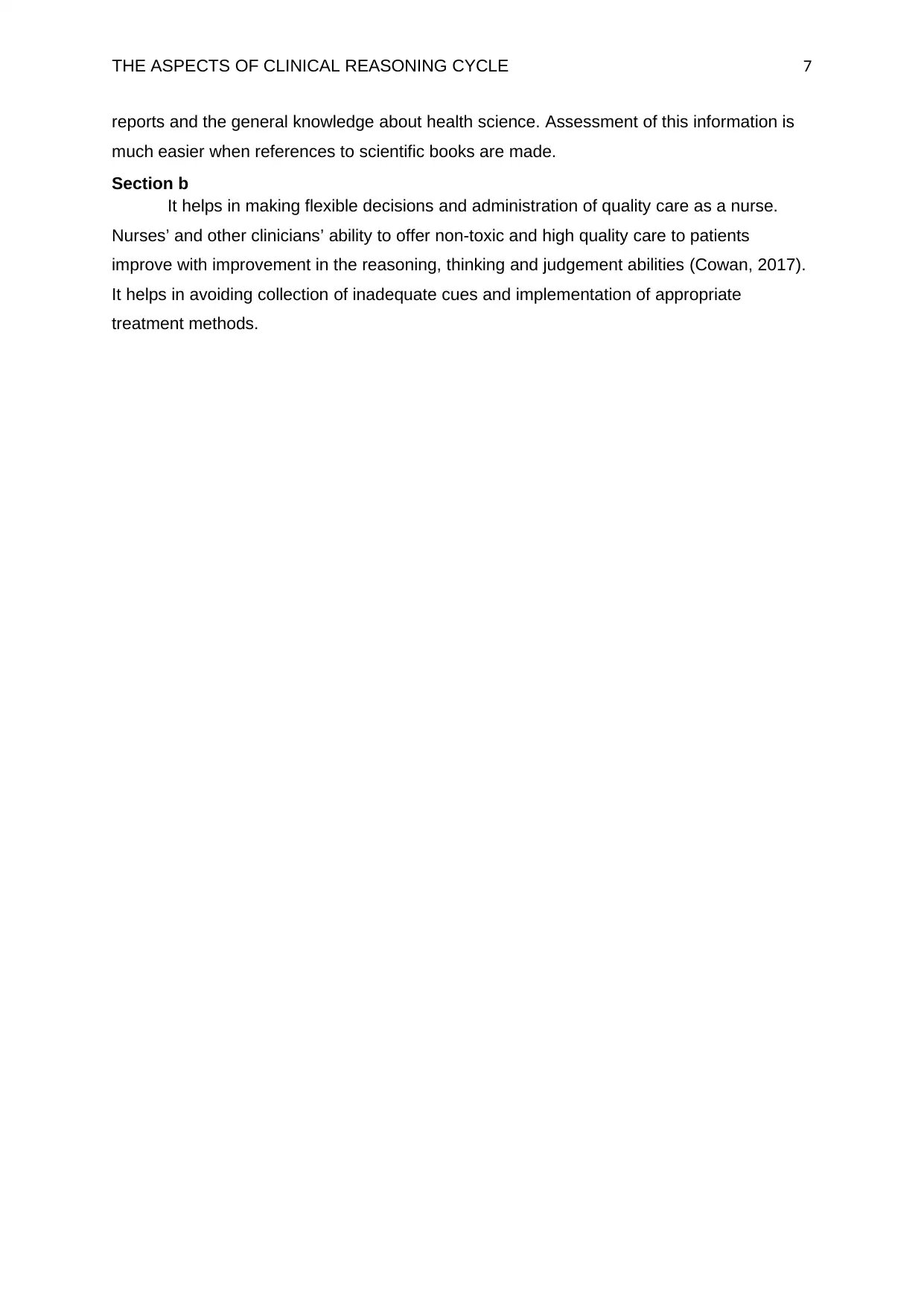
THE ASPECTS OF CLINICAL REASONING CYCLE 7
reports and the general knowledge about health science. Assessment of this information is
much easier when references to scientific books are made.
Section b
It helps in making flexible decisions and administration of quality care as a nurse.
Nurses’ and other clinicians’ ability to offer non-toxic and high quality care to patients
improve with improvement in the reasoning, thinking and judgement abilities (Cowan, 2017).
It helps in avoiding collection of inadequate cues and implementation of appropriate
treatment methods.
reports and the general knowledge about health science. Assessment of this information is
much easier when references to scientific books are made.
Section b
It helps in making flexible decisions and administration of quality care as a nurse.
Nurses’ and other clinicians’ ability to offer non-toxic and high quality care to patients
improve with improvement in the reasoning, thinking and judgement abilities (Cowan, 2017).
It helps in avoiding collection of inadequate cues and implementation of appropriate
treatment methods.
Paraphrase This Document
Need a fresh take? Get an instant paraphrase of this document with our AI Paraphraser
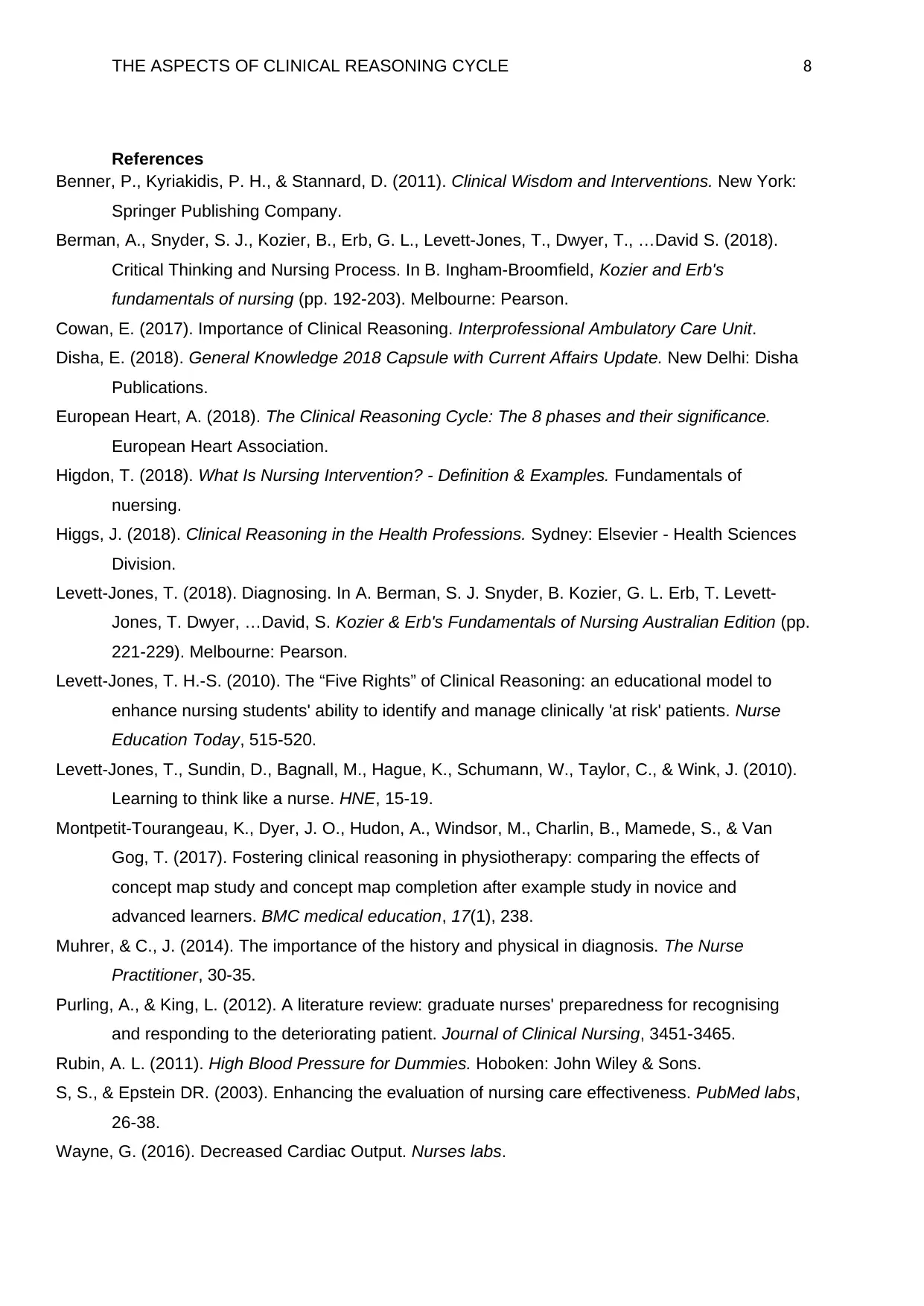
THE ASPECTS OF CLINICAL REASONING CYCLE 8
References
Benner, P., Kyriakidis, P. H., & Stannard, D. (2011). Clinical Wisdom and Interventions. New York:
Springer Publishing Company.
Berman, A., Snyder, S. J., Kozier, B., Erb, G. L., Levett-Jones, T., Dwyer, T., …David S. (2018).
Critical Thinking and Nursing Process. In B. Ingham-Broomfield, Kozier and Erb's
fundamentals of nursing (pp. 192-203). Melbourne: Pearson.
Cowan, E. (2017). Importance of Clinical Reasoning. Interprofessional Ambulatory Care Unit.
Disha, E. (2018). General Knowledge 2018 Capsule with Current Affairs Update. New Delhi: Disha
Publications.
European Heart, A. (2018). The Clinical Reasoning Cycle: The 8 phases and their significance.
European Heart Association.
Higdon, T. (2018). What Is Nursing Intervention? - Definition & Examples. Fundamentals of
nuersing.
Higgs, J. (2018). Clinical Reasoning in the Health Professions. Sydney: Elsevier - Health Sciences
Division.
Levett-Jones, T. (2018). Diagnosing. In A. Berman, S. J. Snyder, B. Kozier, G. L. Erb, T. Levett-
Jones, T. Dwyer, …David, S. Kozier & Erb's Fundamentals of Nursing Australian Edition (pp.
221-229). Melbourne: Pearson.
Levett-Jones, T. H.-S. (2010). The “Five Rights” of Clinical Reasoning: an educational model to
enhance nursing students' ability to identify and manage clinically 'at risk' patients. Nurse
Education Today, 515-520.
Levett-Jones, T., Sundin, D., Bagnall, M., Hague, K., Schumann, W., Taylor, C., & Wink, J. (2010).
Learning to think like a nurse. HNE, 15-19.
Montpetit-Tourangeau, K., Dyer, J. O., Hudon, A., Windsor, M., Charlin, B., Mamede, S., & Van
Gog, T. (2017). Fostering clinical reasoning in physiotherapy: comparing the effects of
concept map study and concept map completion after example study in novice and
advanced learners. BMC medical education, 17(1), 238.
Muhrer, & C., J. (2014). The importance of the history and physical in diagnosis. The Nurse
Practitioner, 30-35.
Purling, A., & King, L. (2012). A literature review: graduate nurses' preparedness for recognising
and responding to the deteriorating patient. Journal of Clinical Nursing, 3451-3465.
Rubin, A. L. (2011). High Blood Pressure for Dummies. Hoboken: John Wiley & Sons.
S, S., & Epstein DR. (2003). Enhancing the evaluation of nursing care effectiveness. PubMed labs,
26-38.
Wayne, G. (2016). Decreased Cardiac Output. Nurses labs.
References
Benner, P., Kyriakidis, P. H., & Stannard, D. (2011). Clinical Wisdom and Interventions. New York:
Springer Publishing Company.
Berman, A., Snyder, S. J., Kozier, B., Erb, G. L., Levett-Jones, T., Dwyer, T., …David S. (2018).
Critical Thinking and Nursing Process. In B. Ingham-Broomfield, Kozier and Erb's
fundamentals of nursing (pp. 192-203). Melbourne: Pearson.
Cowan, E. (2017). Importance of Clinical Reasoning. Interprofessional Ambulatory Care Unit.
Disha, E. (2018). General Knowledge 2018 Capsule with Current Affairs Update. New Delhi: Disha
Publications.
European Heart, A. (2018). The Clinical Reasoning Cycle: The 8 phases and their significance.
European Heart Association.
Higdon, T. (2018). What Is Nursing Intervention? - Definition & Examples. Fundamentals of
nuersing.
Higgs, J. (2018). Clinical Reasoning in the Health Professions. Sydney: Elsevier - Health Sciences
Division.
Levett-Jones, T. (2018). Diagnosing. In A. Berman, S. J. Snyder, B. Kozier, G. L. Erb, T. Levett-
Jones, T. Dwyer, …David, S. Kozier & Erb's Fundamentals of Nursing Australian Edition (pp.
221-229). Melbourne: Pearson.
Levett-Jones, T. H.-S. (2010). The “Five Rights” of Clinical Reasoning: an educational model to
enhance nursing students' ability to identify and manage clinically 'at risk' patients. Nurse
Education Today, 515-520.
Levett-Jones, T., Sundin, D., Bagnall, M., Hague, K., Schumann, W., Taylor, C., & Wink, J. (2010).
Learning to think like a nurse. HNE, 15-19.
Montpetit-Tourangeau, K., Dyer, J. O., Hudon, A., Windsor, M., Charlin, B., Mamede, S., & Van
Gog, T. (2017). Fostering clinical reasoning in physiotherapy: comparing the effects of
concept map study and concept map completion after example study in novice and
advanced learners. BMC medical education, 17(1), 238.
Muhrer, & C., J. (2014). The importance of the history and physical in diagnosis. The Nurse
Practitioner, 30-35.
Purling, A., & King, L. (2012). A literature review: graduate nurses' preparedness for recognising
and responding to the deteriorating patient. Journal of Clinical Nursing, 3451-3465.
Rubin, A. L. (2011). High Blood Pressure for Dummies. Hoboken: John Wiley & Sons.
S, S., & Epstein DR. (2003). Enhancing the evaluation of nursing care effectiveness. PubMed labs,
26-38.
Wayne, G. (2016). Decreased Cardiac Output. Nurses labs.
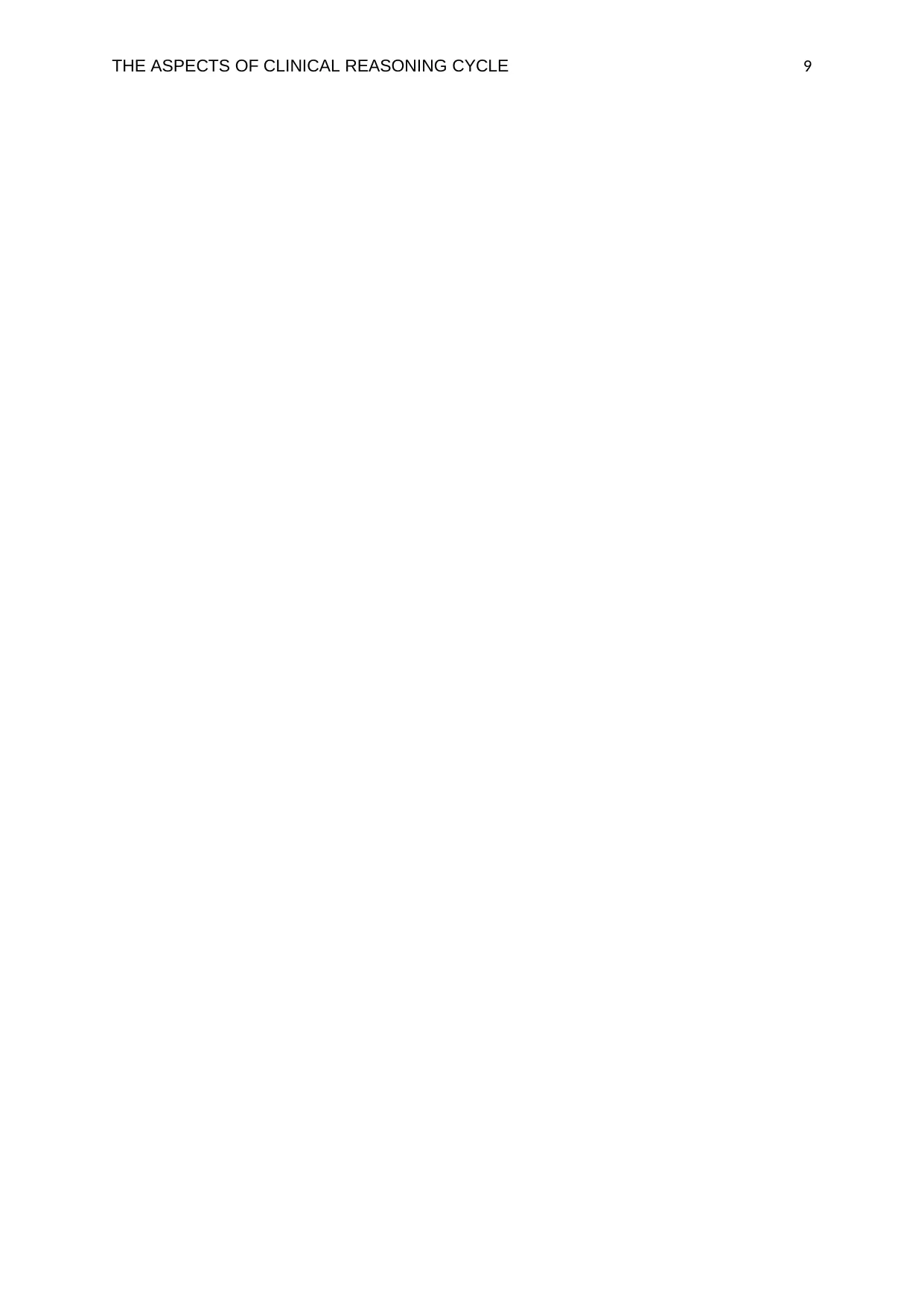
THE ASPECTS OF CLINICAL REASONING CYCLE 9
⊘ This is a preview!⊘
Do you want full access?
Subscribe today to unlock all pages.

Trusted by 1+ million students worldwide
1 out of 9
Related Documents
Your All-in-One AI-Powered Toolkit for Academic Success.
+13062052269
info@desklib.com
Available 24*7 on WhatsApp / Email
![[object Object]](/_next/static/media/star-bottom.7253800d.svg)
Unlock your academic potential
Copyright © 2020–2025 A2Z Services. All Rights Reserved. Developed and managed by ZUCOL.





